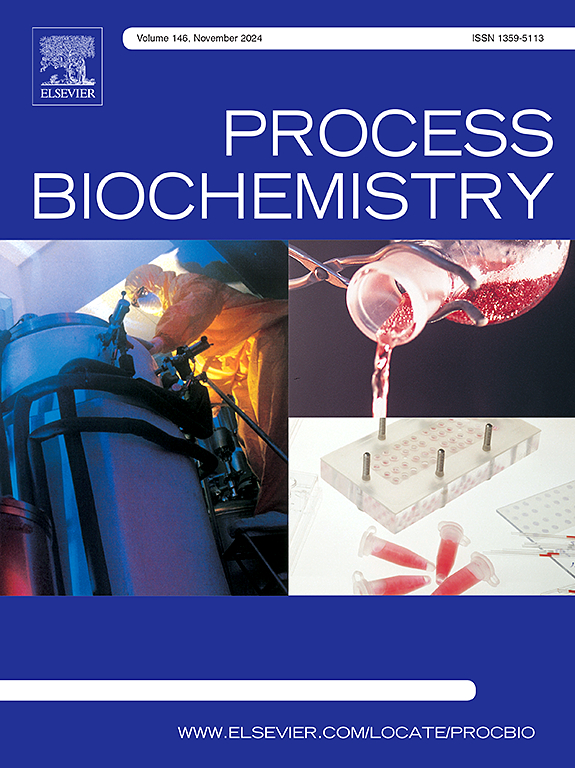利用固定在 Cu-MOF 上的纤维素酶和木聚糖酶同时对城市纸板废料进行糖化和发酵以生产生物乙醇
IF 3.7
3区 生物学
Q2 BIOCHEMISTRY & MOLECULAR BIOLOGY
引用次数: 0
摘要
本研究旨在通过优化城市固体废弃物的重要组成部分--纸板废弃物的酶水解,结合酿酒酵母的发酵,建立一种具有成本效益且环保的生物乙醇生产方法。使用纤维素酶和木聚糖酶混合酶(分别来自热纤维菌和枯草芽孢杆菌)可提高糖化效率。用 2% 的 NaOH 进行预处理后,在固体/基质负荷为 5% 的情况下,糖化效率大幅提高了 66%。通过傅立叶变换红外光谱(FTIR)、X 射线衍射(XRD)和场发射扫描电子显微镜(FESEM)对铜-BTC-MOFs 进行表征,进一步提高了水解效率。与游离酶系统的 66% 相比,固定化混合酶将糖化效率提高到 78%。可重复使用性研究表明,糖化效率在连续循环中逐渐降低,到第十二个循环时达到 71.29%。在优化条件下,将该系统应用于同步糖化和发酵(SSF)装置时,生物乙醇产量显著提高,达到 0.55 克/克,生产率为 0.20 克/升-小时。这项研究通过加强城市纸板废物的酶水解和发酵,为可持续生物乙醇生产和废物价值化提供了潜在的应用前景。该方法展示了扩大生物能源生产规模的前景,有助于应对废物管理挑战,支持绿色能源倡议。本文章由计算机程序翻译,如有差异,请以英文原文为准。
Simultaneous saccharification and fermentation of municipal cardboard waste for bioethanol production using immobilized cellulases and xylanases onto Cu-MOF
This study aims to establish a cost-effective and environmentally friendly method for bioethanol production by optimizing enzymatic hydrolysis of cardboard waste, a significant component of municipal solid waste, in combination with fermentation by Saccharomyces cerevisiae. The use of a cellulases and xylanases enzyme blend, sourced from Thermobifida fusca and Bacillus pumilus, respectively, enhances saccharification efficiency. Pre-treatment with 2 % NaOH results in a substantial 66 % saccharification efficiency at a 5 % solid/substrate loading. Further improvement in hydrolysis efficiency is achieved through enzyme immobilization on Cu-BTC-MOFs, which were characterized by Fourier Transform Infrared Spectroscopy (FTIR), X-ray Diffraction (XRD), and Field Emission Scanning Electron Microscopy (FESEM). The immobilized enzyme blend increases saccharification efficiency to 78 %, compared to 66 % for free enzyme systems. Reusability studies demonstrate a gradual reduction in saccharification efficiency across successive cycles, reaching 71.29 % by the twelfth cycle. When applied in a simultaneous saccharification and fermentation (SSF) setup under optimized conditions, the system yields a notable bioethanol production with a yield of 0.55 g/g and a productivity of 0.20 g/L·h. This study offers potential applications in sustainable bioethanol production and waste valorization by enhancing enzymatic hydrolysis and fermentation of municipal cardboard waste. The approach demonstrates promise for scaling bioenergy production and contributes to addressing waste management challenges, supporting green energy initiatives.
求助全文
通过发布文献求助,成功后即可免费获取论文全文。
去求助
来源期刊

Process Biochemistry
生物-工程:化工
CiteScore
8.30
自引率
4.50%
发文量
374
审稿时长
53 days
期刊介绍:
Process Biochemistry is an application-orientated research journal devoted to reporting advances with originality and novelty, in the science and technology of the processes involving bioactive molecules and living organisms. These processes concern the production of useful metabolites or materials, or the removal of toxic compounds using tools and methods of current biology and engineering. Its main areas of interest include novel bioprocesses and enabling technologies (such as nanobiotechnology, tissue engineering, directed evolution, metabolic engineering, systems biology, and synthetic biology) applicable in food (nutraceutical), healthcare (medical, pharmaceutical, cosmetic), energy (biofuels), environmental, and biorefinery industries and their underlying biological and engineering principles.
 求助内容:
求助内容: 应助结果提醒方式:
应助结果提醒方式:


